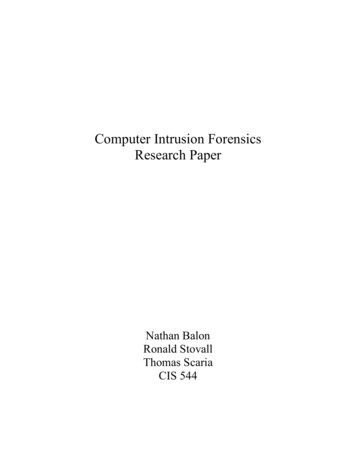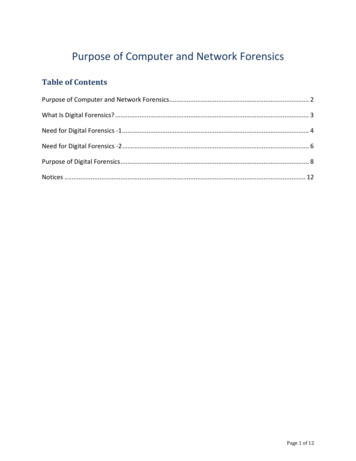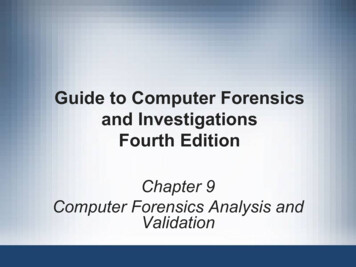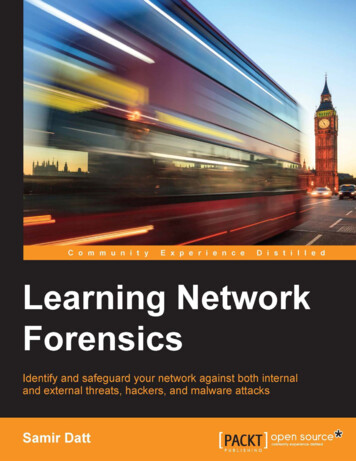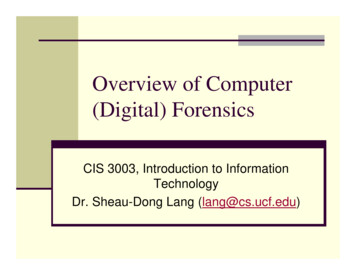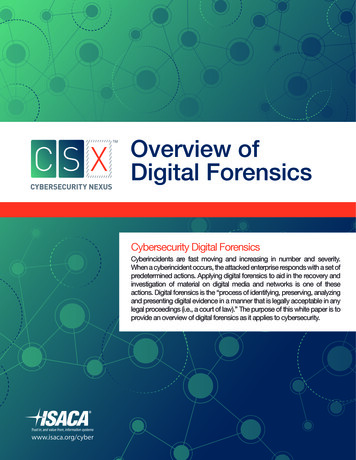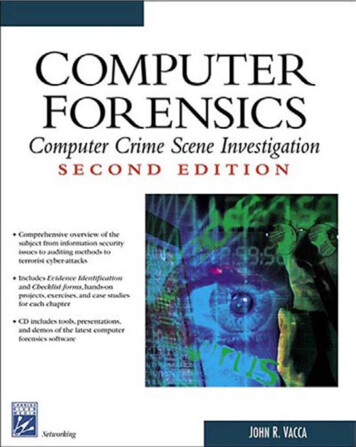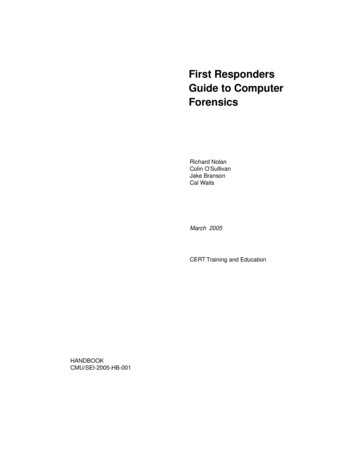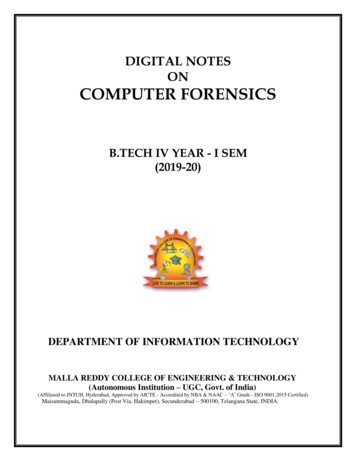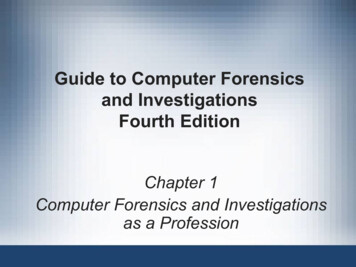
Transcription
Guide to Computer Forensicsand InvestigationsFourth EditionChapter 1Computer Forensics and Investigationsas a Profession
Objectives Define computer forensics Describe how to prepare for computer investigationsand explain the difference between law enforcementagency and corporate investigations Explain the importance of maintaining professionalconductGuide to Computer Forensics and Investigations2
Understanding Computer Forensics Computer forensics– Involves obtaining and analyzing digital information As evidence in civil, criminal, or administrative cases FBI Computer Analysis and Response Team(CART)– Formed in 1984 to handle the increasing number ofcases involving digital evidenceGuide to Computer Forensics and Investigations3
Understanding Computer Forensics(continued)Guide to Computer Forensics and Investigations4
Understanding Computer Forensics(continued) Fourth Amendment to the U.S. Constitution– Protects everyone’s rights to be secure in theirperson, residence, and property From search and seizure– Search warrants are neededGuide to Computer Forensics and Investigations5
Computer Forensics Versus OtherRelated Disciplines Computer forensics– Investigates data that can be retrieved from acomputer’s hard disk or other storage media Network forensics– Yields information about how a perpetrator or anattacker gained access to a network Data recovery– Recovering information that was deleted by mistake Or lost during a power surge or server crash– Typically you know what you’re looking forGuide to Computer Forensics and Investigations6
Computer Forensics Versus OtherRelated Disciplines (continued) Computer forensics– Task of recovering data that users have hidden ordeleted and using it as evidence– Evidence can be inculpatory (“incriminating”) orexculpatory Disaster recovery– Uses computer forensics techniques to retrieveinformation their clients have lost Investigators often work as a team to makecomputers and networks secure in an organizationGuide to Computer Forensics and Investigations7
Computer Forensics Versus OtherRelated Disciplines (continued)Guide to Computer Forensics and Investigations8
Computer Forensics Versus OtherRelated Disciplines (continued) Enterprise network environment– Large corporate computing systems that might includedisparate or formerly independent systems Vulnerability assessment and risk managementgroup– Tests and verifies the integrity of standaloneworkstations and network servers– Professionals in this group have skills in networkintrusion detection and incident responseGuide to Computer Forensics and Investigations9
Computer Forensics Versus OtherRelated Disciplines (continued) Litigation– Legal process of proving guilt or innocence in court Computer investigations group– Manages investigations and conducts forensicanalysis of systems suspected of containing evidencerelated to an incident or a crimeGuide to Computer Forensics and Investigations10
A Brief History of Computer Forensics By the 1970s, electronic crimes were increasing,especially in the financial sector– Most law enforcement officers didn’t know enoughabout computers to ask the right questions Or to preserve evidence for trial 1980s– PCs gained popularity and different OSs emerged– Disk Operating System (DOS) was available– Forensics tools were simple, and most weregenerated by government agenciesGuide to Computer Forensics and Investigations11
A Brief History of Computer Forensics(continued) Mid-1980s– Xtree Gold appeared on the market Recognized file types and retrieved lost or deleted files– Norton DiskEdit soon followed And became the best tool for finding deleted file 1987– Apple produced the Mac SE A Macintosh with an external EasyDrive hard disk with60 MB of storageGuide to Computer Forensics and Investigations12
A Brief History of Computer Forensics(continued)Guide to Computer Forensics and Investigations13
A Brief History of Computer Forensics(continued)Guide to Computer Forensics and Investigations14
A Brief History of Computer Forensics(continued) Early 1990s– Tools for computer forensics were available– International Association of ComputerInvestigative Specialists (IACIS) Training on software for forensics investigations– IRS created search-warrant programs– ExpertWitness for the Macintosh First commercial GUI software for computer forensics Created by ASR DataGuide to Computer Forensics and Investigations15
A Brief History of Computer Forensics(continued) Early 1990s (continued)– ExpertWitness for the Macintosh Recovers deleted files and fragments of deleted files Large hard disks posed problems for investigators Other software– iLook– AccessData Forensic Toolkit (FTK)Guide to Computer Forensics and Investigations16
Understanding Case Law Technology is evolving at an exponential pace– Existing laws and statutes can’t keep up change Case law used when statutes or regulations don’texist Case law allows legal counsel to use previous casessimilar to the current one– Because the laws don’t yet exist Each case is evaluated on its own merit and issuesGuide to Computer Forensics and Investigations17
Developing Computer ForensicsResources You must know more than one computing platform– Such as DOS, Windows 9x, Linux, Macintosh, andcurrent Windows platforms Join as many computer user groups as you can Computer Technology Investigators Network(CTIN)– Meets monthly to discuss problems that lawenforcement and corporations faceGuide to Computer Forensics and Investigations18
Developing Computer ForensicsResources (continued) High Technology Crime InvestigationAssociation (HTCIA)– Exchanges information about techniques related tocomputer investigations and security User groups can be helpful Build a network of computer forensics experts andother professionals– And keep in touch through e-mail Outside experts can provide detailed informationyou need to retrieve digital evidenceGuide to Computer Forensics and Investigations19
Preparing for Computer Investigations Computer investigations and forensics falls into twodistinct categories– Public investigations– Private or corporate investigations Public investigations– Involve government agencies responsible for criminalinvestigations and prosecution– Organizations must observe legal guidelines Law of search and seizure– Protects rights of all people, including suspectsGuide to Computer Forensics and Investigations20
Preparing for Computer Investigations(continued)Guide to Computer Forensics and Investigations21
Preparing for Computer Investigations(continued)Guide to Computer Forensics and Investigations22
Preparing for Computer Investigations(continued) Private or corporate investigations– Deal with private companies, non-law-enforcementgovernment agencies, and lawyers– Aren’t governed directly by criminal law or FourthAmendment issues– Governed by internal policies that define expectedemployee behavior and conduct in the workplace Private corporate investigations also involvelitigation disputes Investigations are usually conducted in civil casesGuide to Computer Forensics and Investigations23
Understanding Law EnforcementsAgency Investigations In a criminal case, a suspect is tried for a criminaloffense– Such as burglary, murder, or molestation Computers and networks are only tools that can beused to commit crimes– Many states have added specific language tocriminal codes to define crimes involving computers Following the legal process– Legal processes depend on local custom, legislativestandards, and rules of evidenceGuide to Computer Forensics and Investigations24
Understanding Law EnforcementsAgency Investigations (continued) Following the legal process (continued)– Criminal case follows three stages The complaint, the investigation, and the prosecutionGuide to Computer Forensics and Investigations25
Understanding Law EnforcementsAgency Investigations (continued) Following the legal process (continued)– A criminal case begins when someone findsevidence of an illegal act– Complainant makes an allegation, an accusation orsupposition of fact– A police officer interviews the complainant andwrites a report about the crime Police blotter provides a record of clues to crimesthat have been committed previously– Investigators delegate, collect, and process theinformation related to the complaintGuide to Computer Forensics and Investigations26
Understanding Law EnforcementsAgency Investigations (continued) Following the legal process (continued)– After you build a case, the information is turned overto the prosecutor– Affidavit Sworn statement of support of facts about or evidenceof a crime– Submitted to a judge to request a search warrant Have the affidavit notarized under sworn oath– Judge must approve and sign a search warrant Before you can use it to collect evidenceGuide to Computer Forensics and Investigations27
Understanding Law EnforcementsAgency Investigations (continued)Guide to Computer Forensics and Investigations28
Understanding CorporateInvestigations Private or corporate investigations– Involve private companies and lawyers who addresscompany policy violations and litigation disputes Corporate computer crimes can involve:––––––E-mail harassmentFalsification of dataGender and age discriminationEmbezzlementSabotageIndustrial espionageGuide to Computer Forensics and Investigations29
Understanding CorporateInvestigations (continued) Establishing company policies– One way to avoid litigation is to publish and maintainpolicies that employees find easy to read and follow– Published company policies provide a line of authority For a business to conduct internal investigations– Well-defined policies Give computer investigators and forensic examiners theauthority to conduct an investigation Displaying Warning Banners– Another way to avoid litigationGuide to Computer Forensics and Investigations30
Understanding CorporateInvestigations (continued) Displaying Warning Banners (continued)– Warning banner Usually appears when a computer starts or connects tothe company intranet, network, or virtual private network Informs end users that the organization reserves the rightto inspect computer systems and network traffic at will Establishes the right to conduct an investigation– As a corporate computer investigator Make sure company displays well-defined warning bannerGuide to Computer Forensics and Investigations31
Understanding CorporateInvestigations (continued)Guide to Computer Forensics and Investigations32
Understanding CorporateInvestigations (continued) Designating an authorized requester– Authorized requester has the power to conductinvestigations– Policy should be defined by executive management– Groups that should have direct authority to requestcomputer investigations Corporate Security InvestigationsCorporate Ethics OfficeCorporate Equal Employment Opportunity OfficeInternal AuditingThe general counsel or Legal DepartmentGuide to Computer Forensics and Investigations33
Understanding CorporateInvestigations (continued) Conducting security investigations– Types of situations Abuse or misuse of corporate assets E-mail abuse Internet abuse– Be sure to distinguish between a company’s abuseproblems and potential criminal problems– Corporations often follow the silver-platter doctrine What happens when a civilian or corporate investigativeagent delivers evidence to a law enforcement officerGuide to Computer Forensics and Investigations34
Understanding CorporateInvestigations (continued) Distinguishing personal and company property– Many company policies distinguish between personaland company computer property– One area that’s difficult to distinguish involves PDAs,cell phones, and personal notebook computers– The safe policy is to not allow any personally owneddevices to be connected to company-owned resources Limiting the possibility of commingling personal andcompany dataGuide to Computer Forensics and Investigations35
Maintaining Professional Conduct Professional conduct– Determines your credibility– Includes ethics, morals, and standards of behavior Maintaining objectivity means you must form andsustain unbiased opinions of your cases Maintain an investigation’s credibility by keeping thecase confidential– In the corporate environment, confidentiality is critical In rare instances, your corporate case might becomea criminal case as serious as murderGuide to Computer Forensics and Investigations36
Maintaining Professional Conduct(continued) Enhance your professional conduct by continuingyour training Record your fact-finding methods in a journal Attend workshops, conferences, and vendor courses Membership in professional organizations adds toyour credentials Achieve a high public and private standing andmaintain honesty and integrityGuide to Computer Forensics and Investigations37
Summary Computer forensics applies forensics procedures todigital evidence Laws about digital evidence established in the 1970s To be a successful computer forensics investigator,you must know more than one computing platform Public and private computer investigations aredifferentGuide to Computer Forensics and Investigations38
Summary (continued) Use warning banners to remind employees andvisitors of policy on computer and Internet use Companies should define and limit the number ofauthorized requesters who can start an investigation Silver-platter doctrine refers to handing the results ofprivate investigations over to law enforcementbecause of indications of criminal activity Computer forensics investigators must maintainprofessional conduct to protect their credibilityGuide to Computer Forensics and Investigations39
Guide to Computer Forensics and Investigations 6 Computer Forensics Versus Other Related Disciplines Computer forensics –Investigates data that can be retrieved from a computer’s hard disk or other storage media Network forensics –Yields information about how a perpetrator
